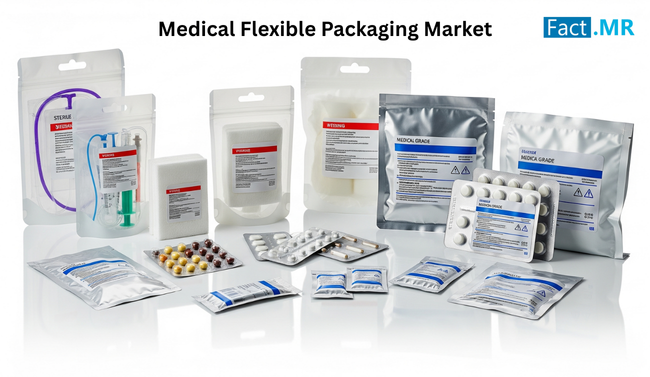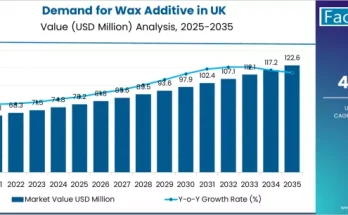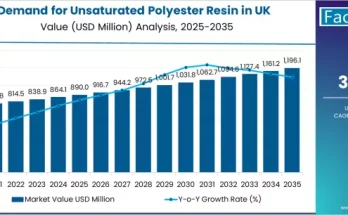The medical flexible packaging market is experiencing rapid growth as healthcare industries focus on ensuring sterility, safety, and product integrity while also addressing environmental sustainability. Flexible packaging solutions—ranging from pouches and bags to films and wraps—are increasingly being adopted for pharmaceuticals, medical devices, diagnostic kits, and surgical instruments.
Medical flexible packaging provides an essential barrier against contamination, moisture, oxygen, and light, thereby preserving the efficacy of sensitive healthcare products. The growing adoption of single-use medical devices, rising demand for safe and convenient drug delivery systems, and heightened regulatory standards have accelerated the need for advanced packaging solutions.
With hospitals, clinics, and pharmaceutical manufacturers prioritizing patient safety, medical flexible packaging is emerging as a vital segment in healthcare supply chains, offering cost-effective, lightweight, and protective solutions compared to traditional rigid packaging alternatives.
Market Overview
Medical flexible packaging encompasses a variety of materials and formats, including polyethylene, polypropylene, laminated films, foils, and biodegradable substrates. These materials provide the flexibility needed for different applications, while maintaining compliance with strict hygiene and sterility standards.
Key attributes driving demand include:
- Barrier Protection: Prevents moisture, oxygen, and microbial contamination.
- Sterility Assurance: Packaging supports sterilization processes like gamma radiation, ethylene oxide, and autoclaving.
- Convenience and Portability: Lightweight and easy-to-handle designs facilitate transport and use in hospitals, pharmacies, and home-care settings.
- Cost-Effectiveness: Flexible packaging uses fewer materials, reducing production and shipping costs compared to rigid alternatives.
Segmentation Analysis
The medical flexible packaging market can be segmented based on material type, product type, application, end-use industry, and region.
- By Material Type:
- Plastic Films (Polyethylene, Polypropylene, PVC) – Provide excellent flexibility, moisture resistance, and processability.
- Laminates & Foils – Offer multi-layer protection for highly sensitive products.
- Biodegradable & Eco-Friendly Materials – Rising adoption due to environmental concerns and regulatory pressures.
- By Product Type:
- Pouches & Bags – Ideal for single-dose pharmaceuticals, IV solutions, and surgical kits.
- Blister Packs & Films – Widely used for tablets, capsules, and diagnostic strips.
- Roll Stock Films & Sheets – Used for wrapping medical devices, instruments, and equipment.
- Sterilization Wraps – Ensures sterility of surgical instruments and devices during storage and transport.
- By Application:
- Pharmaceuticals – Tablets, capsules, injectable drugs, and diagnostic reagents.
- Medical Devices – Catheters, surgical instruments, implants, and wound care products.
- Diagnostic Kits – Point-of-care test kits and laboratory diagnostic products.
- By End-Use Industry:
- Hospitals & Clinics – Require safe and sterilized packaging for surgical instruments and consumables.
- Pharmaceutical Manufacturers – Seek flexible, lightweight, and high-barrier packaging for drugs and vaccines.
- Diagnostic Labs – Demand packaging that preserves the integrity of test kits and sensitive reagents.
- Home Healthcare & Retail – Focus on convenient and easy-to-use packaging for patient self-administration.
- By Region:
- North America: High adoption due to regulatory compliance, stringent sterility standards, and advanced healthcare infrastructure.
- Europe: Focus on eco-friendly and recyclable packaging solutions, supported by environmental policies and sustainability initiatives.
- Asia-Pacific: Rapid growth fueled by increasing healthcare awareness, pharmaceutical production, and medical tourism.
- Rest of the World: Emerging markets are witnessing steady demand driven by hospital expansion, rising disposable income, and growing awareness of safe medical products.
Key Trends and Forecast
- Sustainability and Eco-Friendly Materials:
Environmental awareness and regulatory pressures are driving the development of biodegradable films, recyclable laminates, and water-based coatings. Manufacturers are adopting innovative solutions to minimize packaging waste while maintaining product safety. - Advanced Barrier and Sterility Solutions:
Medical flexible packaging is evolving to provide enhanced oxygen, moisture, and microbial barriers, supporting sterilization processes and extending shelf life. Functional coatings and multi-layer laminates are gaining traction for highly sensitive products. - Digital and Smart Packaging:
Integration of QR codes, RFID tags, and NFC technologyallows tracking of medical products, authentication, and improved supply chain transparency. Smart packaging also enables better inventory management and enhances patient safety. - Growth in Single-Use Medical Devices:
The rising adoption of disposable medical devices and kitshas increased demand for hygienic, lightweight, and cost-effective packaging solutions. Flexible pouches and wraps ensure sterility while reducing shipping and storage costs. - Customization and Design Innovations:
Medical manufacturers are investing in tailored packaging solutionsthat meet specific requirements for product shape, size, sterilization compatibility, and ease of use. This trend improves patient convenience and facilitates efficient hospital operations.
Competitive Landscape
The medical flexible packaging market is competitive and includes both global and regional players. Leading companies focus on research and development, sustainability initiatives, and strategic collaborations to enhance their market presence.
Key Players Include:
- Berry Global, Inc. – Specializes in high-barrier films and sustainable flexible packaging solutions.
- Amcor PLC – Provides innovative, sterilizable packaging solutions for pharmaceuticals and medical devices.
- Sealed Air Corporation – Known for protective medical packaging and sterilization wraps.
- Constantia Flexibles Group GmbH – Offers customized laminates and barrier films.
- Uflex Ltd. – Active in flexible packaging with a focus on healthcare products.
- Winpak Ltd. – Develops high-performance films and pouches for sensitive medical applications.
These companies are investing in advanced materials, digital integration, and environmentally responsible products to differentiate themselves in a competitive market.
Regional Insights
North America remains the most mature market, driven by high healthcare standards, regulatory compliance, and growing adoption of advanced sterilization techniques.
Europe is increasingly adopting eco-friendly and recyclable medical flexible packaging in alignment with sustainability goals and environmental policies.
Asia-Pacific represents the fastest-growing region due to the expansion of pharmaceutical manufacturing, hospital infrastructure development, and rising healthcare awareness in countries like India, China, and Japan.
Emerging regions, including Latin America and the Middle East, are witnessing growth fueled by rising healthcare investments, increased access to medical products, and improvements in hospital facilities.
Challenges and Opportunities
Challenges:
- Stringent regulatory compliance and quality assurance requirements.
- Technical complexities in developing multi-layered, sterilizable, and eco-friendly packaging.
- High costs associated with advanced barrier films and smart packaging solutions.
Opportunities:
- Rising demand for sustainable, biodegradable, and recyclable packaging in medical and pharmaceutical applications.
- Growth in home healthcare and self-administration products, driving demand for user-friendly packaging.
- Adoption of smart and trackable packaging for supply chain transparency and anti-counterfeit measures.
Future Outlook
The medical flexible packaging market is poised for strong growth as healthcare industries continue to emphasize product safety, patient convenience, and environmental sustainability.
- Sustainability Focus: Eco-friendly, biodegradable, and recyclable materials will become standard.
- Innovation: Functional, sterilizable, and smart packaging solutions will expand market opportunities.
- Emerging Markets: Asia-Pacific and other developing regions will drive demand due to healthcare infrastructure expansion and rising awareness of medical product safety.
- Competitive Edge: Companies investing in research, customization, and digital integration will lead the market.
With the global healthcare sector evolving rapidly, medical flexible packaging will remain a cornerstone of patient safety, product integrity, and sustainable practices for years to come.



